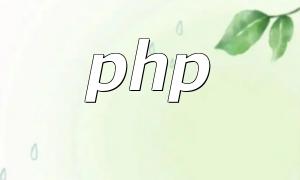In web development, handling user input properly is essential for ensuring application security and data accuracy. Unfiltered input can lead to vulnerabilities such as cross-site scripting (XSS) or SQL injection. PHP8 introduces an improved filtering mechanism—Sanitize Filters—to help developers easily clean and validate incoming data.
Sanitize Filters are built-in PHP mechanisms designed to remove or clean unwanted and potentially harmful data from user input. Different filter types allow developers to strip HTML tags, escape special characters, or correct formats, preventing malicious code from being executed within the system.
Common Sanitize Filter types include:
The filter_var() function is one of the most commonly used filtering methods for handling individual variables:
$input = $_POST['username'];
$sanitized_input = filter_var($input, FILTER_SANITIZE_STRING);
In this example, a username value from $_POST is passed through FILTER_SANITIZE_STRING, removing any HTML tags or unwanted characters.
If you want to directly filter input from global sources such as GET, POST, or COOKIE, the filter_input() function provides a secure and straightforward solution:
$sanitized_input = filter_input(INPUT_POST, 'username', FILTER_SANITIZE_STRING);
This method helps prevent data pollution by avoiding direct access to global arrays.
When handling multiple input variables at once, the filter_var_array() function can be used to apply filters in bulk:
$input = array(
'username' => $_POST['username'],
'password' => $_POST['password']
);
$filters = array(
'username' => FILTER_SANITIZE_STRING,
'password' => FILTER_SANITIZE_STRING
);
$sanitized_input = filter_var_array($input, $filters);
This approach defines a set of filters corresponding to each input variable, returning a cleaned associative array that can be safely used for further processing.
The following is a simple example showing how to filter form data in PHP8 using Sanitize Filters:
<?php
if ($_SERVER["REQUEST_METHOD"] == "POST") {
$input = array(
'username' => $_POST['username'],
'password' => $_POST['password']
);
$filters = array(
'username' => FILTER_SANITIZE_STRING,
'password' => FILTER_SANITIZE_STRING
);
$sanitized_input = filter_var_array($input, $filters);
echo "Username: " . $sanitized_input['username'] . "<br>";
echo "Password: " . $sanitized_input['password'] . "<br>";
}
?>
<form method="post" action="<?php echo $_SERVER['PHP_SELF']; ?>">
<label>Username:</label>
<input type="text" name="username"><br>
<label>Password:</label>
<input type="password" name="password"><br>
<input type="submit" value="Submit">
</form>
In this script, the form data is submitted via POST, filtered using filter_var_array(), and then safely displayed back to the user after sanitization.
Using Sanitize Filters in PHP8 significantly enhances web application security and data integrity. By combining appropriate filters with validation logic, developers can effectively protect against XSS, SQL injection, and other input-related vulnerabilities. Always sanitize and validate all user input as a best practice in secure web development.









